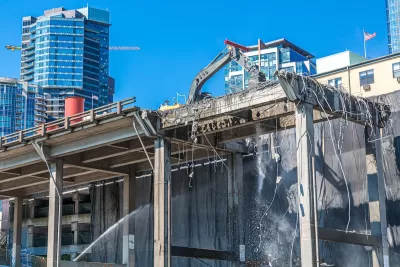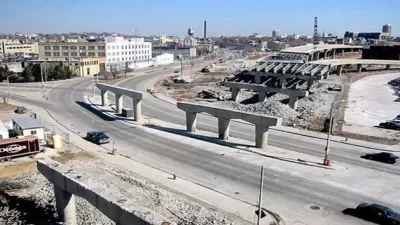Resistance from state transportation departments and precarious funding sources mean highway removal projects are few and far between, despite their benefits.

Highway removal: why isn’t it happening in more places? Joe Harrington poses this question in Next City, noting that “The benefits [of removal] for the communities living along highways are obvious: People have experienced health, environmental, economic and mobility harms for the last 70 years. Communities originally displaced lost billions in generational wealth opportunities in the ensuing displacement and residents today continue to bear harm.”
Harrington lists several reasons that highway removal is not more popular yet. These include “sluggish policy responses” at the federal level that have failed to keep up with the data. Even the Reconnecting Communities program, which is specifically aimed at removing highways, has not resulted in many actual removals. According to Harrington, “There’s an urgent need for federal guidance to leverage successful highway removal initiatives, enabling more cities to pursue this transformative approach.”
Highway removal projects are also stymied by an outdated mindset pervasive in state transportation departments. “Their entrenched traffic engineering mindsets, earmarked funding and institutional resistance to change impede efforts to promote alternatives to highways, from Minnesota to Texas.”
For Harrington, “Current procedures and technical practices—built by and for highway projects—need to shift as we focus on restoring divided neighborhoods, advancing our climate resilience and creating equitable cities.”
FULL STORY: It’s time to start removing highways. For real this time

Trump Administration Could Effectively End Housing Voucher Program
Federal officials are eyeing major cuts to the Section 8 program that helps millions of low-income households pay rent.

Planetizen Federal Action Tracker
A weekly monitor of how Trump’s orders and actions are impacting planners and planning in America.

The 120 Year Old Tiny Home Villages That Sheltered San Francisco’s Earthquake Refugees
More than a century ago, San Francisco mobilized to house thousands of residents displaced by the 1906 earthquake. Could their strategy offer a model for the present?

HSR Reaches Key Settlement in Northern California City
The state’s high-speed rail authority reached an agreement with Millbrae, a key city on the train’s proposed route to San Francisco.

Washington State Legislature Passes Parking Reform Bill
A bill that would limit parking requirements for new developments is headed to the governor’s desk.

Missouri Law Would Ban Protections for Housing Voucher Users
A state law seeks to overturn source-of-income discrimination bans passed by several Missouri cities.
Urban Design for Planners 1: Software Tools
This six-course series explores essential urban design concepts using open source software and equips planners with the tools they need to participate fully in the urban design process.
Planning for Universal Design
Learn the tools for implementing Universal Design in planning regulations.
Ada County Highway District
Clanton & Associates, Inc.
Jessamine County Fiscal Court
Institute for Housing and Urban Development Studies (IHS)
City of Grandview
Harvard GSD Executive Education
Toledo-Lucas County Plan Commissions
Salt Lake City
NYU Wagner Graduate School of Public Service





























